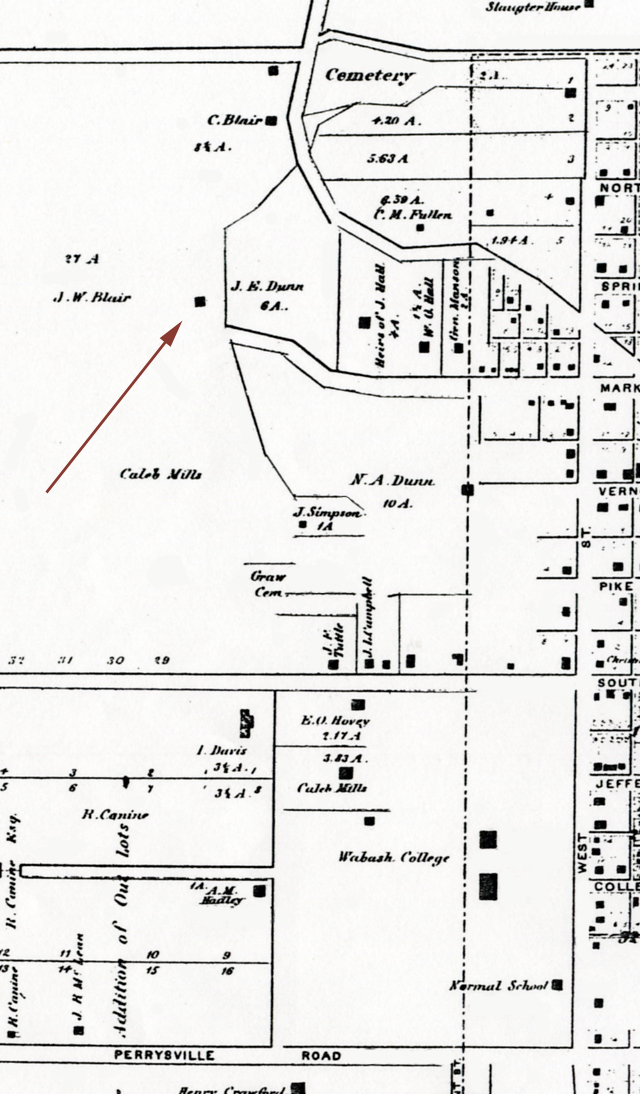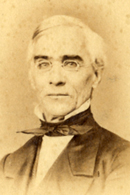On Tuesday, December 3, 2013 Wabash will mark its 180th year of teaching young men. In 1833 Crawfordsville was a very small town, only four blocks wide and five blocks tall. Just a few blocks north of our current campus is where Forest Hall was originally built, on a bluff overlooking Sugar Creek. The map below is from 1860. The red arrow points to the original location of Forest Hall.

In January of 1833 an appeal was printed in the American Home Missionary magazine. It was a posting for the first member of the Wabash faculty. The appeal was for a teacher in the Crawfordsville Classical High School. From the founding minutes of November 21, 1832 we read, “Resolved unanimously that the institution be at first a classical and English High School rising into a college as soon as the wants of the country demand.”
Brother Hovey knows me…
 It seems that Caleb Mills saw this posting and was intrigued enough to write to his friend Edmund O. Hovey, one of the founders, and inquire about the position. In June of 1833 Caleb Mills applied to James Thomson, President of the Board of Trustees, with these words, “Brother Hovey knows me, and is acquainted with my fitness and qualifications for such an office.” A good recommendation must have followed as on July 16, 1833 Mills was appointed as the first member of the faculty.
It seems that Caleb Mills saw this posting and was intrigued enough to write to his friend Edmund O. Hovey, one of the founders, and inquire about the position. In June of 1833 Caleb Mills applied to James Thomson, President of the Board of Trustees, with these words, “Brother Hovey knows me, and is acquainted with my fitness and qualifications for such an office.” A good recommendation must have followed as on July 16, 1833 Mills was appointed as the first member of the faculty.
This position included teaching during the week and preaching in a nearby church over the weekend. Mills did both, often walking several miles out to the church on Sunday morning and, after a good sermon and a good meal, would turn around and walk back to town. This preaching furnished a subsidy to the meager salary provided by Wabash. Later in his life Mills would note that at the beginning of his career, when he worked hardest, he made the least amount of money. As he neared the end of his career, and worked the least, he made his greatest salary.
Part of Caleb Mills’ passion for this position came from his drive to see free common schools available to all children. In a letter to Hovey, Mills stated, “Public sentiment must be changed in regard to free schools, prejudice must be overcome, and the public mind awakened to the importance of carrying the means of education to every door. Though it is the work of years it must and can be done. The sooner we embark in the enterprise the better.” He stayed true to his vision and largely due to his drive and passion; the free public school system was created in Indiana. It is for this good work that he is known as the “Father of the Indiana public school system.”
When Caleb Mills rang in the first class, Forest Hall was unpainted and it made for a humble start. In a March 13, 1833 letter from James Thomson the President of the Board of Trustees, to Williamson Dunn who had donated the land for the new enterprise, Thomson tells Dunn that for the time being they are calling the institution the “Crawfordsville Classical and English High School.” Thomson continues by saying that they will apply for the charter next winter under another name [Wabash Manual Labor College and Teacher’s Seminary] and that they will build a frame building - since they can’t afford bricks.
An alumnus of that era described the scene many years later:
The ground was some distance northwest of the town, not far from Sugar Creek. No wagon road passed nearer than one or two hundred yards north of the building. The western limits of the town extended to what is now called Grant Ave. West of that all was native forest, except a small place a short distance west of this avenue on Main Street, where Nathaniel Dunn had his residence and tan yard; there were also other small clearings being opened up.
“The students who lived or boarded in town, followed a path which passed between the Dunn residence and tan yard: thence northwest through the forest, crossing over two or three rail fences before reaching the College building. The building was frame, unpainted, three stories high including the basement. From the front facing South, where we entered, it was apparently only two stories, the ground sloping gently to the North, so the front entrance was on a level with the ground, while at the North it opened from a basement, also on a level with the ground.
The basement was wholly occupied as a residence for the janitor’s family, who cared for the building and boarded the students, occupying the few rooms not used for chapel and recitations.
As I remember, there were three student rooms in second and third stories. The chapel occupied the east half, less hall room, of the story above the basement. The southwest corner was President Baldwin’s recitation room. The Chapel was used by Professor Mills and the southeast and southwest rooms upstairs by Professors Hovey and Thomson.
This was a humble start with a small frame building and one teacher. It was such a humble start that two of its early trustees resigned as they supposed that Wabash didn’t stand a chance. It was a struggle, and there were times when it looked as if Wabash would not survive. Yet even in those dark pioneer days Mills, Hovey and all who were connected to this little place kept working. Nearly two centuries later as we look back, we know how their story ends. We know they built a college that is strong and lives on today. We have a motto that reflects their struggles, and ours, “Wabash always fights!” Just as it did in the beginning.